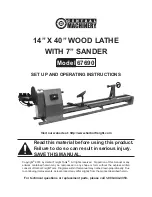
OPERATION
TO SHAPE THE OUTSIDE OF THE BOWL (FIG. 26)
Odd shaped burls, crotches and other irregular
shaped blanks require special preparation before
mounting in a chuck or onto a face plate. Remove the
bark, if there is any from what appears to be the cen-
ter of the top of the workpiece. Drive the spur center
into the top of the workpiece with a mallet or a dead
blow hammer. Slip the spur center into the headstock
taper and bring the tailstock with a live center into po-
sition. Lock the tailstock to the bed and advance the
quill in order to seat the cut center into the workpiece.
Tighten the quill locking handle.
Turn the workpiece by hand to ensure proper clear-
ance. Start the lathe at the lowest speed and bring it
up to the proper speed for the size of the work be-
ing turned. If the machine starts to vibrate, lower the
speed until the vibration stops. Rough out the outside
of the bowl with the bowl gouge, holding the handle
of the tool firmly against your hip.
As the bowl takes shape, work on the bottom (tailstock end) to accommodate attaching a face plate.
Turn a short tenon to the size of the hole in the face plate. This will allow centering the workpiece
when the face plate is attached.
Stop the lathe and remove the workpiece. Attach the face plate or chuck. Finish turning the outside of
the bowl with a bowl gouge. Leave additional material at the base of the bowl for support while turn-
ing the interior. This will be removed later.
TO SHAPE THE INSIDE OF THE BOWL (FIG. 27)
Stop the lathe and move the tailstock away. Adjust the tool rest in front of the bowl just below the
centerline at a right angle to the lathe’s turning axis. Rotate the workpiece by hand to check for clear-
ance.
Start by lightly shearing across the top of the workpiece from rim to center. Place a bowl gouge on
the tool rest at the center of the workpiece with the flute facing the top of the bowl. The tool handle
should be level and pointed toward the four o’clock position.
Use the left hand to control the cutting edge of the gouge, while the right hand swings the tool handle
around towards your body. The flute should start out facing the top of the workpiece, rotating it up-
wards as it moves deeper into the bowl to maintain a clean and even curve. As the tool goes deeper
into the bowl, progressively work outwards towards the rim of the bowl. It may be necessary to turn
the tool rest into the piece as you get deeper into the bowl. NOTE: Try to make one light continuous
movement from the rim to the bottom of the bowl to ensure a clean, sweeping curve through the
Fig. 26
Fig. 27
NOTE:
If you plan to use a chuck, turn a tenon of the appropriate length and diameter to fit your
chuck.
20
Содержание 34027
Страница 23: ...EXPLODED VIEW PARTS LIST 23...


























